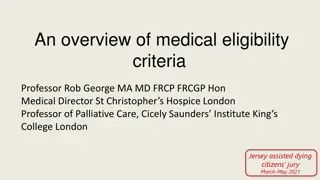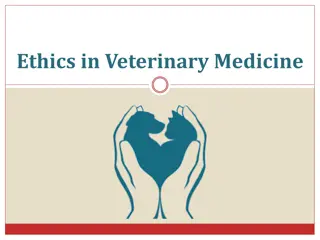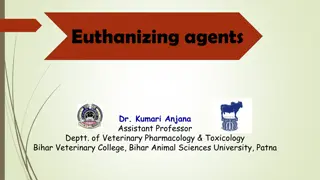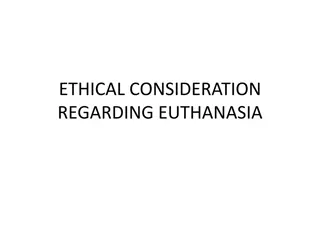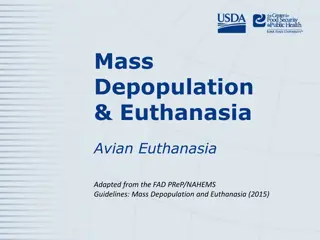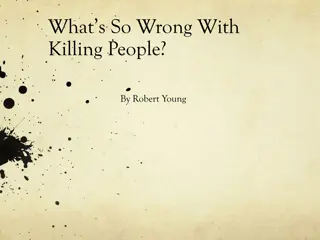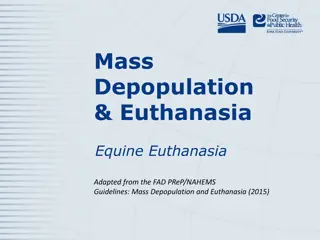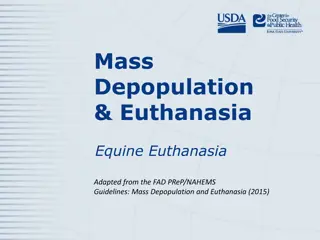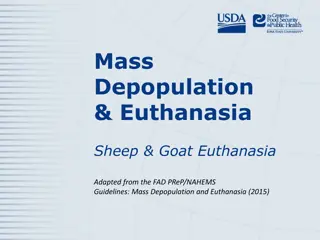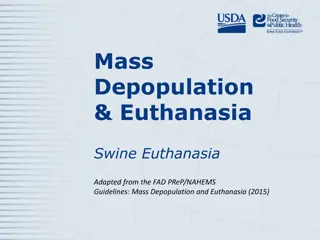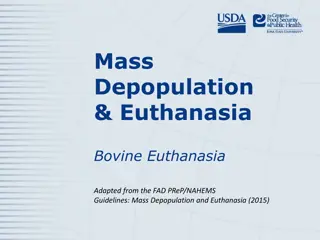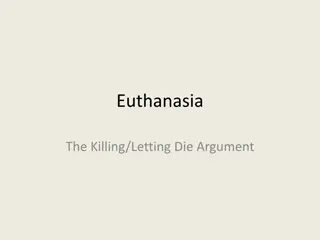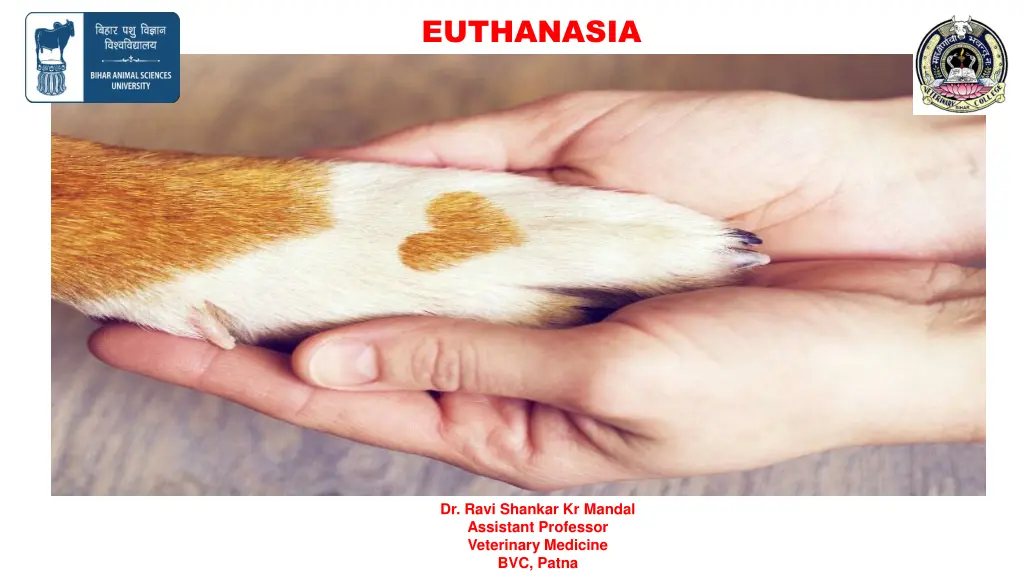
Understanding Euthanasia in Veterinary Medicine
Explore the concept of euthanasia in veterinary medicine, covering its definition, ethical considerations, methods, and important points to consider. Learn about the use of inhalant anesthetics and carbon monoxide, as well as the factors influencing the selection of euthanasia methods. Make informed decisions regarding the humane treatment of animals in hopeless cases where euthanasia may be considered a compassionate option.
Download Presentation

Please find below an Image/Link to download the presentation.
The content on the website is provided AS IS for your information and personal use only. It may not be sold, licensed, or shared on other websites without obtaining consent from the author. If you encounter any issues during the download, it is possible that the publisher has removed the file from their server.
You are allowed to download the files provided on this website for personal or commercial use, subject to the condition that they are used lawfully. All files are the property of their respective owners.
The content on the website is provided AS IS for your information and personal use only. It may not be sold, licensed, or shared on other websites without obtaining consent from the author.
E N D
Presentation Transcript
EUTHANASIA Dr. Ravi Shankar Kr Mandal Assistant Professor Veterinary Medicine BVC, Patna
EUTHANASIA Greek: ( , eu, 'well, good + , thanatos, 'death) Production of quiet, painless death in an animal for humane reasons. Performed for the hopeless cases when treatment would be ineffective and the animal is suffering severe pain Owners request to euthanise animal if the animals have behaviour problems or if the owners no longer wish to own the said animal. The veterinarians should not advocate or recommend euthansia in any specific case. Obtain a consent of the rightful owner or authorised agent in writing on a consent form Failure to obtain owner and/or insurer permission invites a lawsuit. The owner retains all property rights to the animal's body and may either remove it or ask the veterinarian to dispose it off. Before euthanasia is performed, it has to be ascertained that animal involved is indeed the one to be euthanised.
The selection of the method of euthanasia is dependent upon the species of the animal, available means of control of the animal, numbers of animals, economic considerations and the wishes of the owner. Points for consideration during euthanasia The method should produce death without pain. The time to produce unconsciousness and death should be short. The method should be reliable. The method should minimise undesirable psychological stress. The method should be compatible with its purposes. It should minimise the emotional effect upon observers and operators. It should be economically feasible. It should have a restricted environmental impact. It should be safe for the personnel involved.
Methods of euthanasia Pharmacological methods Physical methods Non- inhalant Inhalant Electrocution Shooting
INHALANT ANAESTHETICS Primarily chloroform, ether, halothane and methoxyflurane, have been used for the euthanasia of pups and kittens. The animals are confined in a small, closed chamber into which cotton or gauze saturated with anaesthetics liquid is placed. The vapours are inhaled by the animal until death ensues. Advantages valuable in the euthanasia of young animals when venipuncture is difficult. Disadvantages The struggling and excitement caused by irritant vapours and the stimulation of central nervous system during the induction stage of anaesthesia are undesirable. Ether is flammable hence cannot be used near an open flame. Chronic exposure to chloroform or halothane or methoxyflurane is injurious to personnel. Both halothane and methoxyflurane are expensive.
CARBON MONOXIDE Inhalation of pure carbon monoxide (CO) causes rapid and painless death. It converts the haemoglobin to carboxyhaemoglobin and causes anoxia. Effectively used for the euthanasia of small animals including dogs and cats provided that proper equipment is available and adequate safety precautions are observed. The animals are placed in a closed chamber. Six per cent carbon monoxide concentration gives the fastest results. Chemical interaction of crystals of sodium formate and sulphuric acid. Exhaust fumes from engines combusting petroleum. Use of cylinder gas.
CARBON DIOXIDE Carbon dioxide has been effectively used to euthanise small laboratory animals such as mice, rats, guinea pigs and rabbits. The combination of 40 per carbon dioxide and 3 per cent carbon monoxide is relatively cheap, non-inflammable, non-explosive, odourless and presents no hazard to the operator
HYDROGEN CYANIDE GAS Causes lethal histotoxic anoxia. Effect - rapid, reliable and irreversible. Causes violent convulsive seizures and irritates the respiratory mucosa. Endangers the operator- should not be used for euthanasia. Produced by placing pellets of sodium cyanide in sulphuric acid
NON-INHALANT AGENTS BARBITURATES Used in excessive dosage to produce euthanasia of individual dogs, cats and other small animals Depress the respiratory centre Pentobarbital sodium is often used for euthanasia in small animals Dose : 27 mg/lb (59mg/kg) for intravenous injection and 40 mg/lb (88 mg/kg) for intrapleural or intraperitoneal injection Can be given orally in bait to vicious animals. It produces death quietly and animal appears to go to sleep naturally.
CHLORAL CHLORAL HYDRATE Used for euthanasia in large animals. It fatally depresses the respiratory centres. It is not recommended for use in small animals because of its slow action and death is preceded by unpleasant manifestations such as crying, muscular spasms and gasping. The fatal dose is 0.2 mg per pounds (0.44mg/kg) in horses and is given intravenously relatively Inexpensive HYDRATE STRYCHNINE Strychnine in any form should not be used for euthanasia for any animal. It increases the excitability produces violent muscular contractions. The convulsion produces excruciating pain.
MAGNESIUM SULPHATE Used to produce euthanasia in both small and large animals. The magnesium lon depresses all parts of the central nervous system and unconsciousness occurs prior to fatal respiratory paralysis. Saturated solution (1:1) of magnesium sulphate should be injected intravenously or intracardially in very small animals. The temperature of the solution should be around 40 to 50 c at the time of injection. The magnesium sulphate solution should be injected rapidly to produce a lethal concentration of magnesium ion in blood. Small dogs Large dogs Large animals 10 ml 30 ml 0.5 g per pound body weight
CURARIFORM DRUGS Block neuromuscular transmission and cause paralysis of skeletal muscle These drugs produce death by immobilising the respiratory muscles. There is no depressant action on brain. The use of these drugs to produce euthanasia is not recommended.
PHYSICAL METHODS ELECTROCUTION Usual procedure for electrical destruction of cats to pass on alternating current from the fore feet to hind feet for about one minute, with an open- circuit voltage of 500 to 1000 volts In this methods, the current passes through the thorax but not through the head and brain. Small currents cause death by asphyxiation, while larger ones produce ventricular fibrillation
SHOOTING Accurate and careful shooting is the most humane and the most rapid method of euthanasia. The gunman should stand at a distance of five to eight feet. Instantaneous unconsciousness is produced if the projecile is accurately placed to enter the brain. For dogs and cats the captive-bolt pistol is employed with the barrel held against the target spot. Shooting causes excessive haemorrhage and may be objectionable to the owner of the animal. Adequate precautions must be taken to assure the safety of operating personnel
CONFIRMATION OF DEATH AFTER EUTHANASIA OF ANIMALS CONFIRMATION OF DEATH AFTER EUTHANASIA OF ANIMALS Lack of pulse, breathing, corneal reflexes, and response to painful stimulation Lack of audible heartbeat heard by use of a stethoscope Graying of mucous membranes Rigor mortis
DISPOSAL OF ANIMAL REMAINS AFTER EUTHANASIA DISPOSAL OF ANIMAL REMAINS AFTER EUTHANASIA Animal remains must be disposed of in a legal manner that prevents contamination of food sources or the environment. Any animal intended for food should not be euthanized with a barbiturate. Owners may be informed about disposition options, such as burial, cremation, alkaline hydrolysis, rendering, and other authorized local disposal methods.


